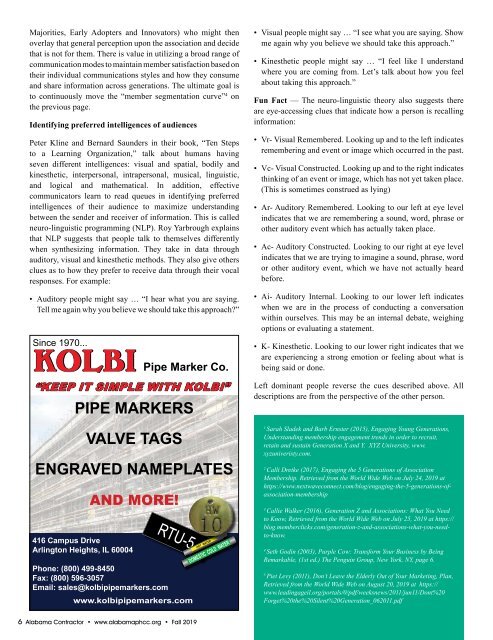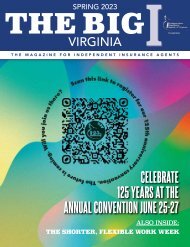Alabama Contractor Fall 2019
You also want an ePaper? Increase the reach of your titles
YUMPU automatically turns print PDFs into web optimized ePapers that Google loves.
Majorities, Early Adopters and Innovators) who might then<br />
overlay that general perception upon the association and decide<br />
that is not for them. There is value in utilizing a broad range of<br />
communication modes to maintain member satisfaction based on<br />
their individual communications styles and how they consume<br />
and share information across generations. The ultimate goal is<br />
to continuously move the “member segmentation curve” 4 on<br />
the previous page.<br />
Identifying preferred intelligences of audiences<br />
Peter Kline and Bernard Saunders in their book, “Ten Steps<br />
to a Learning Organization,” talk about humans having<br />
seven different intelligences: visual and spatial, bodily and<br />
kinesthetic, interpersonal, intrapersonal, musical, linguistic,<br />
and logical and mathematical. In addition, effective<br />
communicators learn to read queues in identifying preferred<br />
intelligences of their audience to maximize understanding<br />
between the sender and receiver of information. This is called<br />
neuro-linguistic programming (NLP). Roy Yarbrough explains<br />
that NLP suggests that people talk to themselves differently<br />
when synthesizing information. They take in data through<br />
auditory, visual and kinesthetic methods. They also give others<br />
clues as to how they prefer to receive data through their vocal<br />
responses. For example:<br />
• Auditory people might say … “I hear what you are saying.<br />
Tell me again why you believe we should take this approach?”<br />
Since 1970...<br />
PIPE MARKERS<br />
VALVE TAGS<br />
ENGRAVED NAMEPLATES<br />
AND MORE!<br />
Pipe Marker Co.<br />
“KEEP IT SIMPLE WITH KOLBI”<br />
416 Campus Drive<br />
Arlington Heights, IL 60004<br />
RTU-5<br />
Phone: (800) 499-8450<br />
Fax: (800) 596-3057<br />
Email: sales@kolbipipemarkers.com<br />
www.kolbipipemarkers.com<br />
HOT WATER<br />
DOMESTIC COLD WATER<br />
• Visual people might say … “I see what you are saying. Show<br />
me again why you believe we should take this approach.”<br />
• Kinesthetic people might say … “I feel like I understand<br />
where you are coming from. Let’s talk about how you feel<br />
about taking this approach.”<br />
Fun Fact — The neuro-linguistic theory also suggests there<br />
are eye-accessing clues that indicate how a person is recalling<br />
information:<br />
• Vr- Visual Remembered. Looking up and to the left indicates<br />
remembering and event or image which occurred in the past.<br />
• Vc- Visual Constructed. Looking up and to the right indicates<br />
thinking of an event or image, which has not yet taken place.<br />
(This is sometimes construed as lying)<br />
• Ar- Auditory Remembered. Looking to our left at eye level<br />
indicates that we are remembering a sound, word, phrase or<br />
other auditory event which has actually taken place.<br />
• Ac- Auditory Constructed. Looking to our right at eye level<br />
indicates that we are trying to imagine a sound, phrase, word<br />
or other auditory event, which we have not actually heard<br />
before.<br />
• Ai- Auditory Internal. Looking to our lower left indicates<br />
when we are in the process of conducting a conversation<br />
within ourselves. This may be an internal debate, weighing<br />
options or evaluating a statement.<br />
• K- Kinesthetic. Looking to our lower right indicates that we<br />
are experiencing a strong emotion or feeling about what is<br />
being said or done.<br />
Left dominant people reverse the cues described above. All<br />
descriptions are from the perspective of the other person.<br />
1<br />
Sarah Sladek and Barb Ernster (2015), Engaging Young Generations,<br />
Understanding membership engagement trends in order to recruit,<br />
retain and sustain Generation X and Y. XYZ University, www.<br />
xyzuniveristy.com.<br />
2<br />
Calli Dretke (2017), Engaging the 5 Generations of Association<br />
Membership. Retrieved from the World Wide Web on July 24, <strong>2019</strong> at<br />
https://www.nextwaveconnect.com/blog/engaging-the-5-generations-ofassociation-membership<br />
3<br />
Callie Walker (2016), Generation Z and Associations: What You Need<br />
to Know, Retrieved from the World Wide Web on July 25, <strong>2019</strong> at https://<br />
blog.memberclicks.com/generation-z-and-associations-what-you-needto-know.<br />
4<br />
Seth Godin (2003), Purple Cow: Transform Your Business by Being<br />
Remarkable, (1st ed.) The Penguin Group, New York, NY, page 6.<br />
5<br />
Piet Levy (2011), Don’t Leave the Elderly Out of Your Marketing, Plan,<br />
Retrieved from the World Wide Web on August 20, <strong>2019</strong> at https://<br />
www.leadingageil.org/portals/0/pdf/weeksnews/2011/jun11/Dont%20<br />
Forget%20the%20Silent%20Generation_062011.pdf<br />
6 <strong>Alabama</strong> <strong>Contractor</strong> • www.alabamaphcc.org • <strong>Fall</strong> <strong>2019</strong>


















